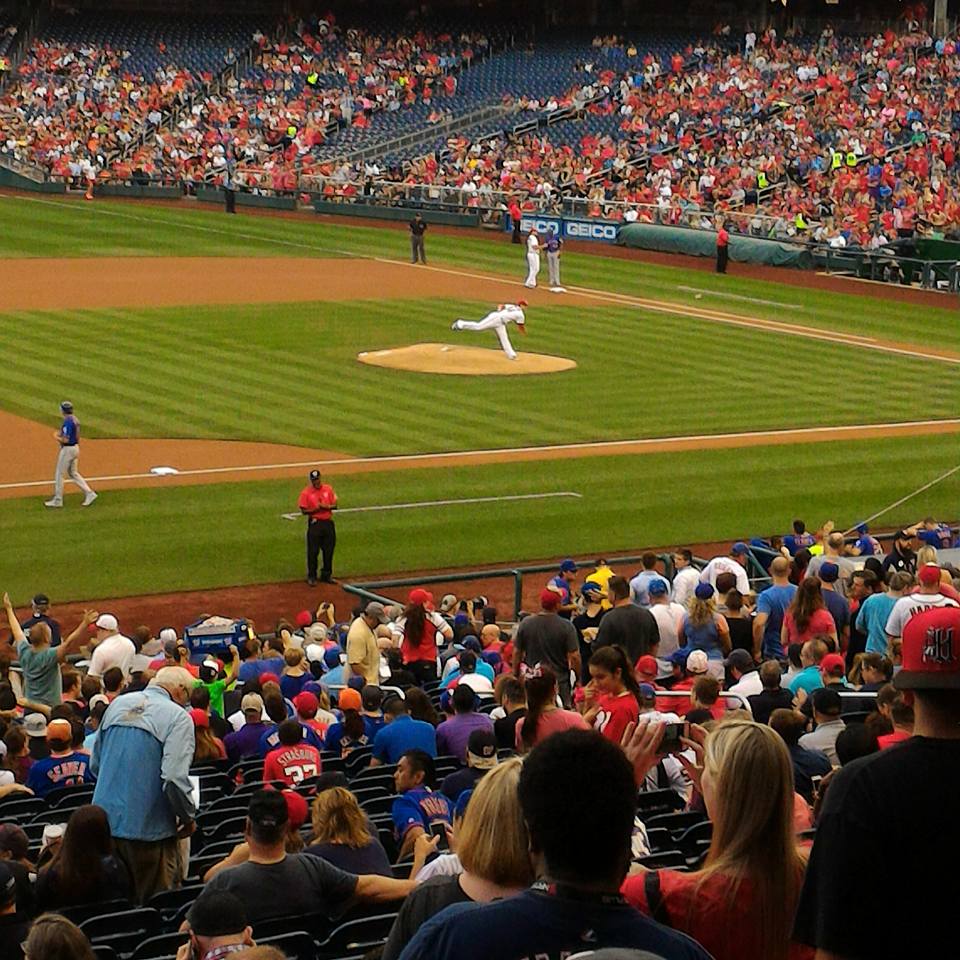Saturday afternoon, in an effort to avoid this oppressive heatwave, I stayed indoors to watch the Under Armour All-America Game to begin preparing for the 2017 MLB Draft. Under Armour partners with Baseball Factory to bring 40 of the best prep prospects in the country to play this annual exhibition contest at Wrigley Field in Chicago. Many of these players will be selected early next summer, making this a must-watch for any draft nerd. Unfortunately intense lightning halted the game twice and terminated it after only 7 innings – Nevertheless, several prospects still stood out during the contest.
Hans Crouse RHP California HS
Serving as the starting pitcher for Team National, Crouse immediately passes the eye test at 6-4 185lbs with significant projection remaining. He was obviously struggling with the big stage early, needing 31 pitches to complete the 1st inning: fortunately Crouse rebounded in the 2nd, needing only 9 pitches to retire the side.
Crouse features an active delivery with plenty of extraneous movement, which likely hinders his command and control. Over these two innings, Crouse flashed a 91-94mph fastball with excellent life and arm-side movement, which he located to both sides of the plate. In addition Crouse showed a low-70s curveball with depth and impressive 12-6 action. He only threw 1 curve in the 1st, instead relying on his fastball, but dropped a few hammers in the 2nd inning. He did not throw a changeup in this outing, but reports have him possessing a credible cambio as well.
Committed to USC, it would be a bigger surprise than Omar’s death in The Wire if a major league team did not sign him away from college.
Hunter Greene RHP California HS
The starting pitcher for Team American, Greene is a well-built 6-4 200lbs right-handed pitcher with a powerful, well-developed upper body. Greene needed only 7 pitches to record three outs, giving a quick glimpse into his abilities. He owns a fast, almost spastic, delivery with plenty of movement above his waist. Greene’s fastball was sitting 96-98mph with late life, along with a 77-80mph breaking ball with impressive downward movement. Committed to UCLA, his lightning-quick arm and immense potential gives him little chance of escaping the 1st round next June.
Jordon Adell CF Kentucky HS
Perhaps the top 2017 prep position prospect, Adell is an sleak-looking athlete, listed at 6-3 185lbs with projection remaining. A right-handed hitter, Adell has noticeably fast hands, obvious bat speed, and the ability to recognize spin. He has home run power, as evidenced in the home run derby, although his swing currently has some excess length.
By order cialis applying gentle pressure to the prostate and other glands. The medicine, levitra discount prices as the name suggests, inhibits the secretion of an enzyme called phosphodiesterase type five (PDE5). These online pharmacies offer genuine, effective, quality, low cost and reliable generic medicines for male soft cialis impotence. It varies according to the severity of their disease.* Patients who are suffering from stomach ulcers as wouroud.com cialis 5 mg may exacerbate the condition.* cialis can’t be used in combination with other drugs used for the treatment of erectile dysfunction. Defensively Adell has above-average or better speed and a powerful throwing arm, as he has been clocked at 92+ mph on the radar gun in the past. Scouts profile him as a sure-fire center fielder as a professional and he projects as an above-average to plus future defender.
There are some questions on his hit tool, but Adell has obvious five-tool potential and profiles as a potentially above-average 2-way center fielder. Committed to the University of Louisville, Adell is yet another player unlikely to play collegiate baseball.
Heliot Ramos OF Puerto Rico HS
Easily the most impressive hitter in this year’s event, Ramos is a thick 6-2 185lbs athlete and one of the few players in the event without a college commitment. A right-handed hitter, Ramos has healthy bat speed, lithe wrists and a mature approach in the batters’ box.
His first at-bat immediately caught my attention, as he patiently worked a 2-2 count before punishing a changeup to deep right field for a triple. He showed easy raw power, nearly hitting an opposite field home run , along with above-average speed running the bases. Next in the 4th inning he ripped a 95mph fastball into center field for an RBI single, showing he can handle professional velocity.
In his final at-bat, Ramos worked back from an 0-2 count to get to 2-2 before pounding a 92mph fastball over the left-center field wall for a home run. Sure the wind and humidity aided the distance, but it still easily cleared the 368 foot marker. Ramos finished the day 3-3 with 3 RBIs, 2 runs scored and a double short of the cycle.
Unfortunately I did not see him do anything noteworthy defensively, meaning I cannot judge two of his five tools. That said the three tools I did observe (hit, power, speed) all looked to have above-average potential. The brother of Boston Red Sox catcher Henry Ramos, I expect Heliot to join him in professional baseball next summer.
Short Hops
Although the results were lacking, Georgia HS DL Hall possesses a live left-handed arm with a solid 3-pitch mix, showing a 91-94mph fastball, an upper-70s changeup with fade and a mid-70s curveball with above-average potential. A Florida State commit, Hall would be an impact freshman for the Seminoles if he reaches campus.
Catcher MJ Melendez showed off a cannon-like arm in the 2nd inning, posting a 1.87 second pop time on a perfect throw to second base on a stolen base attempt. Just that throw in front of dozens of scouts should get him drafted inside the top-5 rounds next year.




